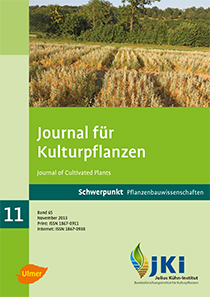Yield stability of winter wheat grown in Brandenburg
DOI:
https://doi.org/10.5073/JfK.2013.11.02Keywords:
Yield stability, ecovalence, floating checks, linear regression, climatic water balanceAbstract
This study of winter wheat varieties grown under environmental conditions in the Brandenburg region focuses on the following question: How do winter wheat varieties differ in terms of yield stability, yield capacity and response to dry weather conditions?
To answer this question, we drew on the results from variety trials carried out over a period of several years and at several different locations in the German Federal State of Brandenburg and analysed different varieties of winter wheat according to the following bio-statistical parameters: ecovalence, linear regression and floating checks. We then estimated different factors affecting yield variability and analysed the response of varieties to different weather conditions according to the climatic water balance.
The study showed that environmental factors had the greatest influence on yield variability, whilst variety had a significantly smaller effect. Nevertheless, there were considerable differences between varieties with regard to yield capacity, yield stability and response to environmental conditions.
The results are equally important for variety testing and evaluation and plant breeding as well as for agricultural practice. They provide information about the variable, environment-dependent traits of varieties and through the development of an evaluation scheme, can help breeders to select optimum varieties and make recommendations of suitable site-adapted varieties to farmers.
Downloads
Published
Issue
Section
License
The content of the journal is licensed under the Creative Commons Attribution 4.0 License. Any user is free to share and adapt (remix, transform, build upon) the content as long as the original publication is attributed (authors, title, year, journal, issue, pages).
The copyright of the published work remains with the authors. The authors grant the Journal of Cultivated Plants, the Julius Kühn-Institut and the OpenAgrar repository the non-exclusive right to distribute and exploit the work.







